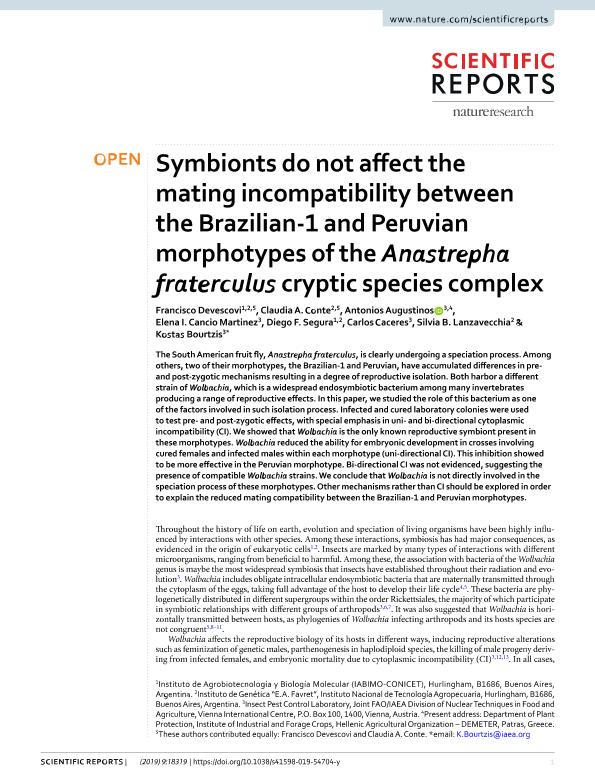Mostrar el registro sencillo del ítem
dc.contributor.author
Devescovi, Francisco

dc.contributor.author
Conte, Claudia Alejandra

dc.contributor.author
Augustinos, Antionios
dc.contributor.author
Cancio Martinez, Elena
dc.contributor.author
Segura, Diego Fernando

dc.contributor.author
Caceres, Carlos
dc.contributor.author
Lanzavecchia, Silvia Beatriz

dc.contributor.author
Bourtzis, Kostas
dc.date.available
2023-01-24T12:59:36Z
dc.date.issued
2019-12
dc.identifier.citation
Devescovi, Francisco; Conte, Claudia Alejandra; Augustinos, Antionios; Cancio Martinez, Elena; Segura, Diego Fernando; et al.; Symbionts do not affect the mating incompatibility between the Brazilian-1 and Peruvian morphotypes of the Anastrepha fraterculus cryptic species complex; Nature Publishing Group; Scientific Reports; 9; 1; 12-2019
dc.identifier.uri
http://hdl.handle.net/11336/185387
dc.description.abstract
The South American fruit fly, Anastrepha fraterculus, is clearly undergoing a speciation process. Among others, two of their morphotypes, the Brazilian-1 and Peruvian, have accumulated differences in pre- and post-zygotic mechanisms resulting in a degree of reproductive isolation. Both harbor a different strain of Wolbachia, which is a widespread endosymbiotic bacterium among many invertebrates producing a range of reproductive effects. In this paper, we studied the role of this bacterium as one of the factors involved in such isolation process. Infected and cured laboratory colonies were used to test pre- and post-zygotic effects, with special emphasis in uni- and bi-directional cytoplasmic incompatibility (CI). We showed that Wolbachia is the only known reproductive symbiont present in these morphotypes. Wolbachia reduced the ability for embryonic development in crosses involving cured females and infected males within each morphotype (uni-directional CI). This inhibition showed to be more effective in the Peruvian morphotype. Bi-directional CI was not evidenced, suggesting the presence of compatible Wolbachia strains. We conclude that Wolbachia is not directly involved in the speciation process of these morphotypes. Other mechanisms rather than CI should be explored in order to explain the reduced mating compatibility between the Brazilian-1 and Peruvian morphotypes.
dc.format
application/pdf
dc.language.iso
eng
dc.publisher
Nature Publishing Group

dc.rights
info:eu-repo/semantics/openAccess
dc.rights.uri
https://creativecommons.org/licenses/by/2.5/ar/
dc.subject
ANASTREPHA FRATERCULUS
dc.subject
REPRODUCTIVE SYMBIONT
dc.subject
WOLBACHIA
dc.subject
CYTOPLASMIC INCOMPATIBILITY
dc.subject
PEST CONTROL
dc.subject.classification
Otras Agricultura, Silvicultura y Pesca

dc.subject.classification
Agricultura, Silvicultura y Pesca

dc.subject.classification
CIENCIAS AGRÍCOLAS

dc.title
Symbionts do not affect the mating incompatibility between the Brazilian-1 and Peruvian morphotypes of the Anastrepha fraterculus cryptic species complex
dc.type
info:eu-repo/semantics/article
dc.type
info:ar-repo/semantics/artículo
dc.type
info:eu-repo/semantics/publishedVersion
dc.date.updated
2023-01-24T10:24:38Z
dc.identifier.eissn
2045-2322
dc.journal.volume
9
dc.journal.number
1
dc.journal.pais
Reino Unido

dc.journal.ciudad
Londres
dc.description.fil
Fil: Devescovi, Francisco. Instituto Nacional de Tecnología Agropecuaria. Centro de Investigación en Ciencias Veterinarias y Agronómicas. Instituto de Agrobiotecnología y Biología Molecular. Grupo Vinculado Instituto de Genética "Ewald A. Favret" al Iabimo | Consejo Nacional de Investigaciones Científicas y Técnicas. Oficina de Coordinación Administrativa Parque Centenario. Instituto de Agrobiotecnología y Biología Molecular. Grupo Vinculado Instituto de Genética "Ewald A. Favret" al Iabimo; Argentina
dc.description.fil
Fil: Conte, Claudia Alejandra. Instituto Nacional de Tecnología Agropecuaria. Centro de Investigación en Ciencias Veterinarias y Agronómicas. Instituto de Genética; Argentina. Consejo Nacional de Investigaciones Científicas y Técnicas; Argentina
dc.description.fil
Fil: Augustinos, Antionios. Vienna International Centre; Austria
dc.description.fil
Fil: Cancio Martinez, Elena. Vienna International Centre; Austria
dc.description.fil
Fil: Segura, Diego Fernando. Instituto Nacional de Tecnologia Agropecuaria. Centro de Investigacion En Ciencias Veterinarias y Agronomicas. Instituto de Agrobiotecnologia y Biologia Molecular. Grupo Vinculado Instituto de Genetica "ewald A. Favret" Al Iabimo | Consejo Nacional de Investigaciones Cientificas y Tecnicas. Oficina de Coordinacion Administrativa Pque. Centenario. Instituto de Agrobiotecnologia y Biologia Molecular. Grupo Vinculado Instituto de Genetica "ewald A. Favret" Al Iabimo.; Argentina
dc.description.fil
Fil: Caceres, Carlos. Vienna International Centre; Austria
dc.description.fil
Fil: Lanzavecchia, Silvia Beatriz. Instituto Nacional de Tecnología Agropecuaria. Centro de Investigación en Ciencias Veterinarias y Agronómicas. Instituto de Genética; Argentina. Instituto Nacional de Tecnología Agropecuaria. Centro de Investigación en Ciencias Veterinarias y Agronómicas. Instituto de Agrobiotecnología y Biología Molecular. Consejo Nacional de Investigaciones Científicas y Técnicas. Oficina de Coordinación Administrativa Parque Centenario. Instituto de Agrobiotecnología y Biología Molecular; Argentina
dc.description.fil
Fil: Bourtzis, Kostas. Vienna International Centre; Austria
dc.journal.title
Scientific Reports
dc.relation.alternativeid
info:eu-repo/semantics/altIdentifier/url/https://www.nature.com/articles/s41598-019-54704-y
dc.relation.alternativeid
info:eu-repo/semantics/altIdentifier/doi/https://doi.org/10.1038/s41598-019-54704-y
Archivos asociados
